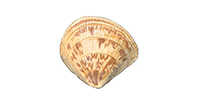Thank you for visiting the Seafood Selector. EDF is planning a new approach to providing information to consumers about good seafood choices. Please come back soon for updates.
Clams

Littleneck Clam, © Amadeo Bachar
Recommended servings per month
| Contaminant | Men | Women | Kids 6-12 | Kids 0-5 | |
|---|---|---|---|---|---|
| Butter Clam (farmed) | Mercury | 4+ | 4+ | 4+ | 4+ |
| Manila clam (farmed) | Mercury | 4+ | 4+ | 4+ | 4+ |
| Pacific geoduck (farmed and wild - US, Canada) | Mercury | 4+ | 4+ | 4+ | 4+ |
| Pacific littleneck (farmed) | Mercury | 4+ | 4+ | 4+ | 4+ |
| Northern quahog | Mercury | 4+ | 4+ | 4+ | 4+ |
| Blood cockle (farmed) | Mercury | 4+ | 4+ | 4+ | 4+ |
| Ocean quahog (wild) | Mercury | 4+ | 4+ | 4+ | 4+ |
| Atlantic surfclam (wild) | Mercury | 4+ | 4+ | 4+ | 4+ |
| Softshell clam | Mercury | 4+ | 4+ | 4+ | 4+ |
Eco details:
- Northern quahogs (or hard clams) are the most commonly eaten species of clams in the U.S. and the ones most likely to be found in fish markets and grocery stores.
- Quahogs go by different names depending on their size (littlenecks, cherrystones, chowder clams).
- These clams come from wild fisheries and farms, and capturing methods and farming practices generally do little ecological damage.




